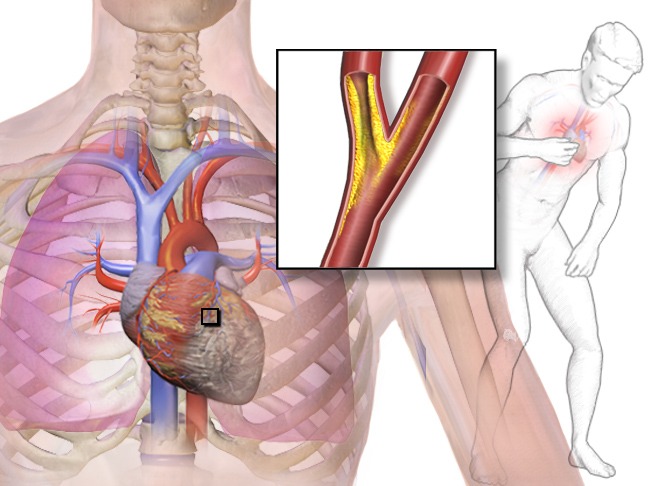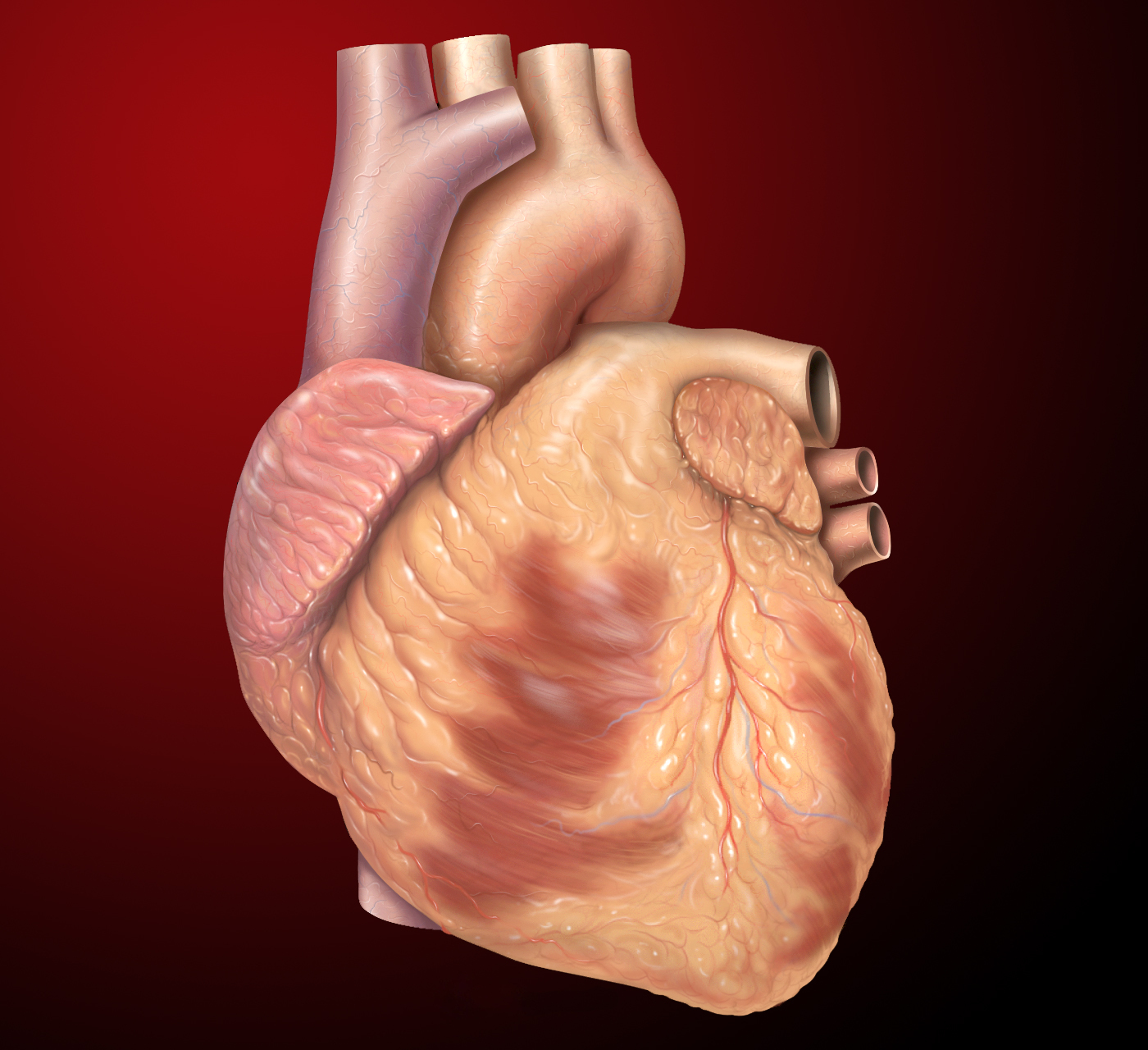Difference Between Stable and Unstable Angina
Angina is a type of chest pain, resulting from reduced blood flow to the heart.

What is Stable Angina?
In physical exertion or emotional stress, pressing or constricting pain appears behind the sternum (in the middle or at its left edge). Often the pain is spreading to the hands, neck and lower jaw. The pain lasts for a few minutes. It passes quickly after discontinuation of the physical effort or taking nitroglycerin under the tongue (within 2-3 minutes).
The angina is stable when the seizures appear for more than one month and there are no significant changes in the main features of the pain.
In the most cases, the reason for the stable angina is stenotic coronary atherosclerosis with stable plaques. Relatively rare causes are coronaritis, congenital coronary abnormalities, a muscular bridge in the coronary artery.
During a seizure of stable angina, the patients may be pale or red, anxious, but avoiding movement, often sweaty, with a moderate tachycardia. Often the pain is preceded by a rise in the blood pressure. There may be an alternating pulse and a pre-systolic, rarely diastolic or summation gallop.
The disturbances in the functional state of the ischemia-affected area can be detected by echocardiography, phonocardiography and especially by cardiac catheterization and isotopic examination.
The stable angina is manifested in the same way for a long period of time – seizures occur in certain provocative moments and are short term. Other manifestations of ischemic heart disease are missing and the condition remains unchanged.
Stable angina includes post-prandial pain and nighttime pain. They are generally an expression of more advanced and severe coronary atherosclerosis, but without progression over a certain period of time.
In the diagnosis of stable angina, it should be borne in mind that the symptoms may be atypical as well as inconsistent and altered in strength. The history and monitoring of the patient remain crucial for the diagnosis. The electrocardiography (ECG) in exercise is an important supplementary method. Coronary angiography is usually not done.
Angina may also occur in some heart diseases, such as aortic stenosis and insufficiency, idiopathic hypertrophic cardiomyopathy, and coronary artery disease. Similar pains can also occur in pericarditis, pulmonary embolism, and pulmonary hypertension.

What is Unstable Angina?
The angina is considered unstable when the seizures:
- Have started recently (less than 4-6 weeks ago);
- Occur in lesser provocation or spontaneously, incl. at rest;
- Are longer and stronger than those in stable angina;
- Can lead to a heart attack.
The seizures are an expression of progressive coronary atherosclerosis. Unstable angina includes clinical variants with differences in pathogenesis, prognosis, and risk of heart attack:
- Recently occurred angina – for the first time or again, but after a long painless period;
- Stable angina becoming an unstable one;
- Spontaneous angina – the seizures (which have recently appeared for the first time or in the background of stable angina) occur at rest, without provocation, last longer and are stronger.
The development of the different forms may be different. All forms in a short time period can be followed by a myocardial infarction or stable angina. It is even possible the seizures to stop. The prognosis is comparatively the most optimistic in the recently occurred angina and significantly more serious in its changing form (from stable to unstable angina), where the seizures become more severe, especially if they do not end after a 48-hour rest and treatment. The prognosis is even more serious in spontaneous unstable angina.
The seizures in all forms of unstable angina may be anything in between common angina and myocardial infarction. Clinically, when necrosis is proven, the case is already in the category of heart attacks.
In seizures of unstable angina, there are marked changes in the functional state of the affected areas of the myocardium and in the intracardiac hemodynamics – wall hypokinesia, a shorter period of blood discharge, marked decrease of the stroke index, increase of the pressure in the left ventricle with corresponding clinical and paraclinical signs.
The ECG, taken during a seizure of unstable angina, frequently shows changes that persist for hours and days after the seizure – ST-segment depression and ischemic T-wave but without changes in QRS.
In case of unstable angina, the ECG at exercise is contraindicated. Coronary angiography is recommendable.
Sometimes there may be no changes, but most often there are such in 1 to 3 vessels, and there is often stenosis of the left main coronary artery. The frequency of normal results from the coronary angiography is about 10%.
Difference Between Stable and Unstable Angina
Definition
Stable angina: The angina is stable when the seizures appear in physical exertion or emotional stress, for more than one month, and there are no significant changes in the main features of the pain.
Unstable angina: The angina is considered unstable when the seizures have started recently, occur in lesser provocation or spontaneously, and are longer and stronger than those in stable angina.
Chest pain
Stable angina: The pain occurs in physical exertion or emotional stress. It lasts 2-5 minutes.
Unstable angina: The pain occurs at rest. It lasts more than 10 minutes.
Pathology
Stable angina: Ischemia due to fixed stenosis of the arteries, supplying blood to the heart.
Unstable angina: Ischemia due to dynamic obstruction of the arteries, supplying blood to the heart, resulting from plaque rupture with superimposed spasm and thrombosis.
Predictability
Stable angina: The seizures are often predictable, as they are related to physical exertion or emotional stress.
Unstable angina: The seizures are not predictable.
Treatment
Stable angina: The pain passes quickly after discontinuation of the physical effort or taking nitroglycerin under the tongue.
Unstable angina: Emergent treatment is necessary due to the risk of myocardial infarction and cardiac arrest.
Diagnosis
Stable angina: The ECG in exercise is an important method. Coronary angiography is usually not done.
Unstable angina: The ECG at exercise is contraindicated. Coronary angiography is recommendable.
ECG
Stable angina: The ECG is often normal.
Unstable angina: The ECG frequently shows changes – ST-segment depression and ischemic T-wave but without changes in QRS.
Here is the comparison chart to show you the difference between Stable and Unstable Angina

Summary of Stable vs Unstable Angina
- Angina is a type of chest pain, resulting from reduced blood flow to the heart.
- The angina is stable when the seizures appear in physical exertion or emotional stress, for more than one month, and there are no significant changes in the main features of the pain.
- The angina is considered unstable when the seizures have started recently, occur in lesser provocation or spontaneously, and are longer and stronger than those in stable angina.
- The pain in stable angina occurs in physical exertion or emotional stress. In unstable angina the pain occurs at rest.
- The pain in stable angina lasts 2-5 minutes, in unstable angina it lasts more than 10 minutes.
- The ischemia in stabile angina is due to fixed stenosis of the arteries, supplying blood to the heart. In unstable angina the ischemia is due to dynamic obstruction of these arteries, resulting from rupture of plaque with superimposed spasm and thrombosis.
- The seizures of stable angina are often predictable, while the seizures of unstable angina are not predictable.
- In stable angina the pain passes quickly after discontinuation of the physical effort or taking nitroglycerin under the tongue. For unstable angina emergent treatment is necessary.
- In stable angina the ECG in exercise is an important supplementary method. Coronary angiography is usually not done. In unstable angina the ECG at exercise is contraindicated. Coronary angiography is recommendable.
- The ECG in stable angina is often normal, while in unstable angina the ECG frequently shows changes.
- Difference Between Gallstones and Cholecystitis - September 5, 2021
- Difference Between Constipation and Cramping - August 4, 2021
- Difference Between Whole Genome Sequencing and Microarray - May 6, 2021
Search DifferenceBetween.net :
1 Comment
Leave a Response
References :
[0]Davidson, C. Understanding Angina and Heart Attacks. Poole: Family Doctor Books. Print. 2007
[1]Gallo, A., M. Jones (Eds.). Angina Pectoris: Etiology, Pathogenesis and Treatment. Runcorn: Nova Biomedical. 2008. Print.
[2]Sarembock, I., F. Elahdab, D. Isbell, M. Ragosta. Angina: An Atlas of Investigation and Management 1st Edition. Oxford: Clinical Publishing. 2007. Print.
[3]Image credit: https://commons.wikimedia.org/wiki/File:Blausen_0022_Angina.png
[4]Image credit: https://en.wikipedia.org/wiki/Heart#/media/File:Heart_anterior_exterior_view.jpg

It was interesting reading on this page and it gives you more details